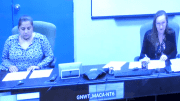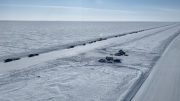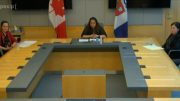The 19th Legislative Assembly’s first budget reflects much more business as usual than any significant changes.
Finance Minister Caroline Wawzonek acknowledged as much, saying the budget is money the departments need to maintain programs and services they have now.
All put together, that comes to $1.9 billion in departmental spending.
Overall, the GNWT forecasts $2.2 billion in revenue and $2 billion in expenditures, therefore running a $203 million operating surplus.
Last year, it anticipated running a $60 million surplus, but that turned into a $70 million deficit after federal infrastructure money was pushed back to this year’s budget.
Department of Finance officials explained that many funding agreements with the federal government don’t kick in until certain conditions are met, such as planning studies. These conditions were not met in the past fiscal year, so the funding has been delayed to this year.
Some of the funding is for projects like pre-development for the Taltson hydro expansion, the Mackenzie Valley Highway Project and the Tlicho All-Season Road.
Mandate money
Since this new government has taken over, it’s faced pressure to address several issues across multiple departments.
Housing across the territory needs major upgrades, an Auditor General report criticized the growing disparity in student outcomes, and, of course, there’s the perennial problem of Child and Family Services.
However, you’d be hard-pressed to find any money directly addressing any of these issues in the latest budget.
Minister Wawzonek said there wasn’t much time for her to make changes after being elected, but promised this year’s budget “isn’t the whole picture or the whole story of what this government is going to do.”
There is $25 million over the next four years set aside for the government’s mandate priorities.
Asked if she thought that would be enough money, “It’s what you do with it,” she replied. “I think there’s a lot you can do with $25 million over a population the size of the Northwest Territories.” She added that ensuring departments are performing adequately will also help “leverage” money that is already there.
Finally, she was asked if the government was moving fast enough to address the issues outlined above.
“Sometimes I think acting too quickly is the reaction of government because you want to show, ‘Look we’ve done something, we’re throwing some money at something,” she said. “The approach we want to take is to stand up and take the criticism of not acting fast enough and instead taking the time to make sure we’re using our money the best possible way.”
Growing debt
While the GNWT is forecasting running a surplus over the life of this government—albeit one that shrinks every year—it also expects to continue to accumulate debt.
Not only is it inching closer to the federally-imposed borrowing limit, it expects to hit that $1.3 billion wall within a couple of years. The GNWT is currently in talks with the federal government to raise that limit, something it last did in 2015.
Minister Wawzonek said raising the debt limit is still well within the government’s fiscal strategy.
You may be wondering how a government that runs a surplus is also gaining more debt.
Essentially, the surplus money is going towards infrastructure projects and not to pay off that debt.
It’s no secret revenues from the mines will continue to go down as they come to a close, the local fishing industry continues to decline, as is the number and value of pelts. The NWT has some of the oldest infrastructure in the country, and some of the lowest social indicators. Granted, tourism numbers continue to grow, but overall it makes for a bleak economic picture.
And that is precisely why the government will keep investing in infrastructure projects rather than aggressively pay down the debt, says Wawzonek.
“We have an economy that’s really pretty stagnant right now and not a lot of signs of recovery in the near future. In my view, that’s not necessarily the time you want to start to pay down your debt aggressively as opposed to investing in infrastructure and looking for opportunities,” she said. “We need to really be focusing on growing our economy and bringing people into the North in order to be better positioned to pay down that debt in the future.”
Below are this year’s budget documents:
Francis was a reporter with CKLB from January 2019 to March 2023. In his time with CKLB, he had the immense pleasure and honour of learning about northern Indigenous cultures.









